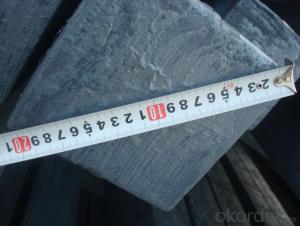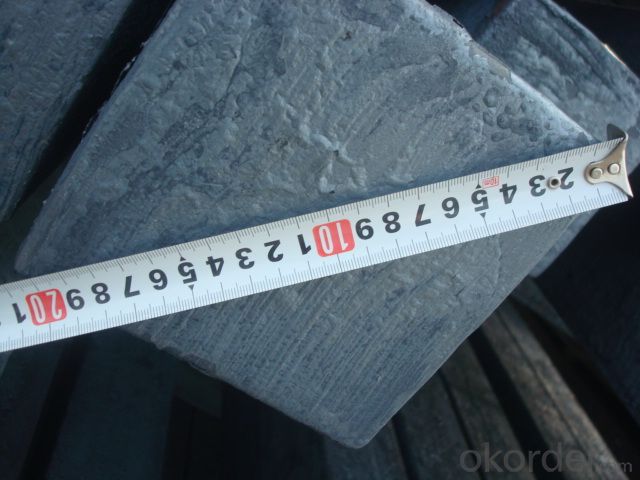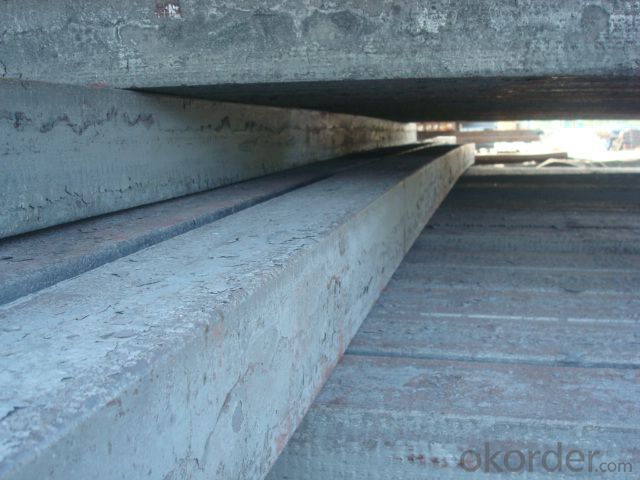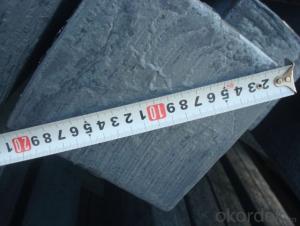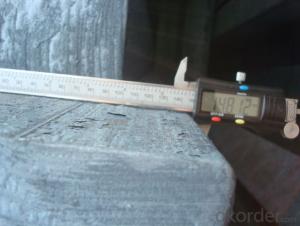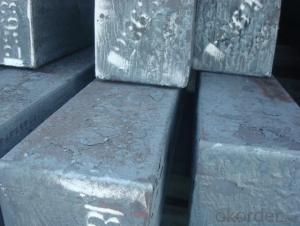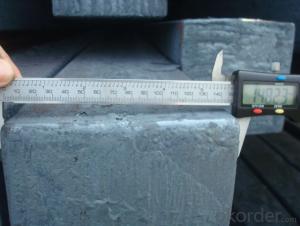Continuous Casting Steel Billet Q275/235 in Amazing Price
- Loading Port:
- Tianjin
- Payment Terms:
- TT OR LC
- Min Order Qty:
- 1000 m.t.
- Supply Capability:
- 200000 m.t./month
OKorder Service Pledge
OKorder Financial Service
You Might Also Like
STEEL BILLET
1.Structure of Steel Billet
Steel billet(ingot) by cogging or breakdown of semi-finished products, is the raw material of all kinds of steel mill. Billet section of square, round, flat, rectangular and abnormity of several kinds of, mainly related to the shape of rolled products.
2.Main Features of Steel Billet
Rectangular billet continuous casting billet and mainly general carbon steel, low carbon low silicon cold-rolled material, high quality carbon structural steel, high strength low alloy steel, special steel, etc.
The billet is mainly divided into two kinds from the shape:
Slab: cross section width and height of the ratio of the larger, mainly used for rolling plate.
Billet: equal cross section width and height, or a huge difference, mainly used for rolling steel, wire rod. ,
Steel billets have distinct characteristics as compared with already furnished steel bars and products. Billets have a specific grain structure, which enables the metal to be processed more intricately. Steel billets are also known for their malleability and ductility, especially when exposed to varying temperatures during shaping and molding.
3.Processing of Steel Billet
Steel billets are considered fresh and raw, and they must undergo a series of manufacturing processes before they can be used for various purposes. Billets are made by means of freezing molten liquid, and are later exposed to extremely low temperatures in order to allow the metal to take shape and solidify in chemical structure. The temperature manipulates the metal's physical properties, and tones its strength and durability. The subsequent processes provide the metal's curved mold design so that it can fit the allotted space provided by other machines, which complete the finishing procedures.
4.Steel Billet Images
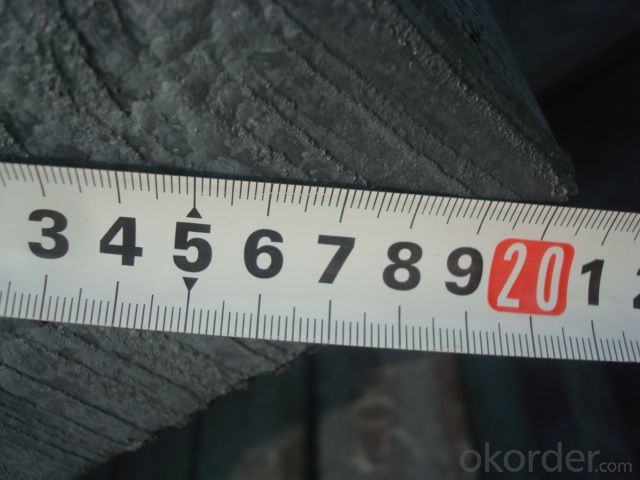
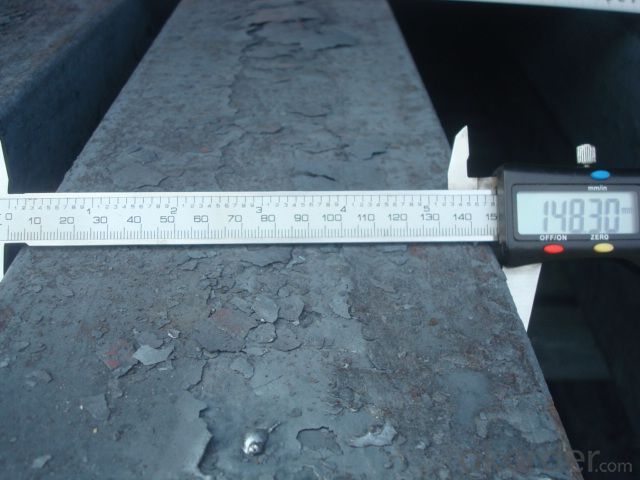
5.Usage of Steel Billet
Billets, or ingots (as they sometimes referred to), are not of practical use until they have been formed into more functional shapes and sizes. While they have already been put in the furnace, they still require a series of shaping and molding procedures such as hot and cold working, milling and cutting before they are sold in hardware stores, or used for different applications. The unformed billets, however, can be used in striking currency such as coins and as reserves, similar to gold bars.
6. Steel Billet Specification
Hot rolled billet steel
Size: 50x50mm-180x180mm
Steel Grade: 3SP, 5SP,Q195,Q235,Q255,Q275 Length:3m-12m
MOQ: 1000MT/size
Payment term: TT or LC
Packing: in bulk , bundle
Shipment: by container , bulk vessel
Packaging Details: bundles with steel strips or as customers's requirements
Delivery time: 15-30 days after the deposit
Loading port:Tianjin, or other port China
Origin :China
Inspection:Third party inspection before loading.
7.FAQ
We have organized several common questions for our clients,may help you sincerely:
1) How about your company?
A world class manufacturer & supplier of castings forging in carbon steel and alloy steel,is one of the large-scale professional investment casting production bases in China,consisting of both casting foundry forging and machining factory. Annually more than 8000 tons Precision casting and forging parts are exported to markets in Europe,America and Japan. OEM casting and forging service available according to customer’s requirements.
2) How long can we receive the product after purchase?
In the purchase of product within three working days, We will arrange the factory delivery as soon as possible. The pecific time of receiving is related to the state and position of customers.Commonly 7 to 10 working days can be served.
3)Do you have your own QC department?
Yes, we have, our QC department will inspect the goods during the process of mass production and after completion of production.
4)If there’s something wrong with the quality of the products, how do we return the goods?
We promise you the quality will be the same as the samples you confirmed. If there’s something wrong with the quality of the products, please send back sample from the shipment goods to us and let us know the quantity, then we will investigate in our work shop. If it is our problem, we will offer you discount or replacements for free.
- Q: What are the factors that determine the lifespan of steel billets?
- There are several factors that determine the lifespan of steel billets. These include the quality of the initial raw materials used in the production of the billets, the manufacturing process employed, the storage and handling conditions, as well as the environmental factors such as exposure to corrosive substances or extreme temperatures. Additionally, the maintenance and care taken during use, including proper lubrication and cleaning, can also impact the lifespan of steel billets.
- Q: What are the safety precautions in handling steel billets?
- To prevent accidents and injuries, it is necessary to adhere to specific safety precautions when handling steel billets. Some of the essential precautions include: 1. Personal Protective Equipment (PPE): Always wear appropriate PPE, such as safety goggles, gloves, steel-toed boots, and protective clothing. This will safeguard against potential hazards like sharp edges, falling objects, and flying debris. 2. Lifting Techniques: Employ proper lifting techniques, such as bending the knees and using the legs to lift. This will help avoid strains or injuries to the back. If the billets are too heavy to lift manually, utilize mechanical lifting equipment like cranes or forklifts. 3. Secure Storage: Ensure that steel billets are stored securely and stably. This will prevent them from toppling or rolling, which can lead to injuries or damage to equipment and infrastructure. To keep the billets organized and secure, employ suitable storage racks, bins, or pallets. 4. Handling Tools: Safely handle steel billets using appropriate tools such as lifting hooks, clamps, or tongs. Avoid using your hands or body to move or reposition the billets, as this can result in pinching, crushing, or cutting injuries. 5. Clear and Well-Defined Work Area: Maintain a work area around the steel billets that is clear and well-defined. This will prevent tripping hazards. Remove any obstructions or debris that could cause slips, trips, or falls. 6. Communication and Training: Ensure that all personnel involved in handling steel billets receive sufficient training in safe handling procedures and are aware of potential hazards. Establish clear communication channels to coordinate movements and actions, especially when using machinery or working in teams. 7. Inspection and Maintenance: Regularly inspect the condition of the steel billets, lifting equipment, and storage racks to identify any potential safety issues. Promptly address any defects, damages, or signs of wear and tear to prevent accidents. 8. Emergency Procedures: Establish emergency procedures and ensure that all personnel are familiar with them. This includes procedures for handling accidents, injuries, spills, or other emergencies that may occur during the handling of steel billets. By adhering to these safety precautions, the risk of accidents and injuries can be minimized, creating a safer working environment for those involved in handling steel billets.
- Q: How is the demand for steel billets projected to change in the future?
- Various factors are expected to cause significant changes in the demand for steel billets in the future. One of the main drivers of this change is the overall expansion of the construction and infrastructure sectors. As economies continue to develop, there will be an increasing need for steel billets to support the construction of buildings, bridges, roads, and other infrastructure projects. Moreover, the demand for steel billets is also expected to be influenced by the automotive industry. The rising popularity of electric vehicles and the need for lightweight materials to enhance fuel efficiency may lead to the substitution of steel billets with alternative materials like aluminum or carbon fiber in certain automotive applications. Furthermore, the renewable energy sector is another potential factor that could impact the demand for steel billets. As the world shifts towards cleaner energy sources, there will be a growing requirement for wind turbines and solar panels, which predominantly rely on steel. This could result in an increased demand for steel billets in the production of these renewable energy components. Additionally, advancements in technology and manufacturing processes may also affect the demand for steel billets. As new techniques and materials are developed, there is a possibility that steel billets could be replaced by alternative materials or manufacturing methods that offer superior performance or cost-efficiency. In conclusion, while the demand for steel billets is projected to remain strong in the foreseeable future, it is likely to undergo changes based on the growth of construction, infrastructure, automotive, and renewable energy sectors, as well as advancements in technology and materials.
- Q: What are the different heat treatment processes for alloy steel billets?
- There are several different heat treatment processes for alloy steel billets, including annealing, normalizing, quenching, and tempering. Annealing involves heating the billets to a high temperature and then slowly cooling them to relieve internal stresses and improve ductility. Normalizing is similar to annealing but involves air cooling instead of slow cooling. Quenching involves rapidly cooling the billets in a liquid medium, such as oil or water, to increase hardness and strength. Tempering is done after quenching and involves reheating the billets to a specific temperature and then cooling them slowly to reduce brittleness and improve toughness.
- Q: Billet heating furnace prices?
- Look at the video case, you can consult the advisory.
- Q: What are the different surface defects in steel billets?
- Some common surface defects in steel billets include cracks, scars, pits, surface roughness, and scale.
- Q: What is the role of steel billets in the manufacturing of cutting tools?
- The manufacturing of cutting tools heavily relies on steel billets. These billets act as the primary material from which the cutting tool is forged or machined. Typically, steel billets are composed of high-quality steel alloys, which possess vital properties like hardness, toughness, and wear resistance that are necessary for cutting tools. To initiate the manufacturing process, the steel billets are heated to a specific temperature called the forging temperature. This temperature allows the steel to become malleable, making it easier to shape and mold into the desired cutting tool. The heated billets are then subjected to a forging process using specialized equipment, where they are struck or pressed to shape them into the desired form, such as drills, saws, or blades. Following the initial forging, the billets undergo further machining to refine their shape and dimensions. Machining processes like milling, turning, and grinding are employed to eliminate excess material, achieve precise dimensions required for the cutting tool, and create the desired cutting edge geometry. The quality of the steel billets used in the manufacturing process significantly impacts the performance and durability of the cutting tool. Steel billets with high carbon content and alloying elements like chromium, vanadium, or tungsten are often preferred as they enhance the hardness, strength, and wear resistance of the cutting tool. These properties are essential to ensure that the cutting tool can withstand the high forces, temperatures, and abrasive conditions it will encounter during use. In conclusion, steel billets serve as the foundation for manufacturing cutting tools. They provide the necessary raw material and properties required to create high-quality cutting tools that demonstrate exceptional performance, durability, and precision.
- Q: What are the different surface treatments applied to alloy steel billets?
- Enhancing the properties and performance of alloy steel billets can be achieved through various surface treatments. One commonly used treatment involves bombarding the billet surface with small metal or ceramic particles at high velocity, a process known as shot blasting. This effectively eliminates impurities and contaminants, resulting in a clean and uniform surface finish. Additionally, shot blasting promotes the adhesion of subsequent coatings or treatments. Another method, known as pickling, entails immersing the billets in an acid solution to remove oxides and scale from the surface. This not only improves the surface quality but also eliminates any defects, preparing the billets for further processing or treatments. Heat treatment is a popular surface treatment for alloy steel billets. By subjecting the billets to controlled heating and cooling processes, their microstructure can be altered, leading to improved mechanical properties. This treatment can enhance the hardness, strength, and toughness of the billets, rendering them more suitable for specific applications. Furthermore, alloy steel billets can be coated with protective coatings to enhance corrosion resistance and durability. Common techniques include hot-dip galvanizing, electroplating, and painting. These coatings serve as a barrier between the alloy steel surface and the environment, effectively preventing corrosion and extending the lifespan of the billets. To summarize, shot blasting, pickling, heat treatment, and protective coatings are among the various surface treatments applied to alloy steel billets. These treatments enhance surface quality, improve mechanical properties, and protect against corrosion, ensuring optimal performance in diverse applications.
- Q: What are the main factors affecting the dimensional stability of steel billets?
- The dimensional stability of steel billets can be influenced by various factors. These factors include temperature, cooling rate, composition, mechanical stresses, heat treatment, and manufacturing techniques. Firstly, temperature plays a significant role in the dimensional stability of steel billets. Depending on the temperature they are exposed to, the billets can undergo thermal expansion or contraction. To minimize dimensional changes, it is important to carefully control the temperature during the manufacturing process and subsequent cooling stages. Secondly, the rate at which the steel billets cool down after being heated also affects their dimensional stability. Rapid cooling can result in internal stresses and cause warping or distortion, while slow cooling can lead to uneven dimensional changes. Thirdly, the chemical composition of the steel billets is a crucial factor. Different alloying elements, impurities, and carbon content can influence the behavior of the material during heating and cooling. Higher carbon content, for example, increases the likelihood of warping or distortion. Moreover, mechanical stresses from handling, transportation, or machining processes can impact the dimensional stability of steel billets. Excessive bending, twisting, or pressure can cause permanent deformation or residual stresses, thus affecting overall dimensional stability. Furthermore, the heat treatment process also plays a role in the dimensional stability of steel billets. Different heat treatment methods can introduce internal stresses or phase transformations that may alter the billet's dimensions. Lastly, the manufacturing techniques used during the production of steel billets can have an impact on their dimensional stability. Inadequate control or inconsistencies in casting, rolling, or forging processes can result in variations in the billet's dimensions. Considering and controlling these factors is crucial to ensure the dimensional stability of steel billets. Any dimensional changes can have consequences for subsequent processing steps and the overall quality of the final product.
- Q: What is the purpose of steel billets?
- Steel billets have a vital role in the steel manufacturing industry, as they act as the primary material for producing a range of steel products. These billets are semi-finished goods that usually have a square or rectangular shape, and they are created through the casting or hot rolling process. Once formed, these billets undergo further processing, including forging, rolling, or extrusion, to manufacture finished steel products such as bars, rods, wire, pipes, and tubes. The significance of steel billets lies in their ability to provide a consistent and uniform starting material that can be easily molded and shaped into various products. With desirable qualities like strength, durability, and ductility, these billets are well-suited for applications in construction, automotive, infrastructure, machinery, and many other industries. By utilizing steel billets, manufacturers can efficiently produce steel products with precise dimensions, mechanical properties, and surface finishes. By controlling the composition and processing techniques of the billets, steel manufacturers can customize the final product to meet specific customer requirements, ensuring optimal performance and quality. In conclusion, steel billets serve as the foundation for manufacturing various steel products. They play a crucial role in shaping and forming steel into the desired finished products, enabling industries to effectively meet the diverse needs of modern society.
Send your message to us
Continuous Casting Steel Billet Q275/235 in Amazing Price
- Loading Port:
- Tianjin
- Payment Terms:
- TT OR LC
- Min Order Qty:
- 1000 m.t.
- Supply Capability:
- 200000 m.t./month
OKorder Service Pledge
OKorder Financial Service
Similar products
Hot products
Hot Searches
Related keywords
